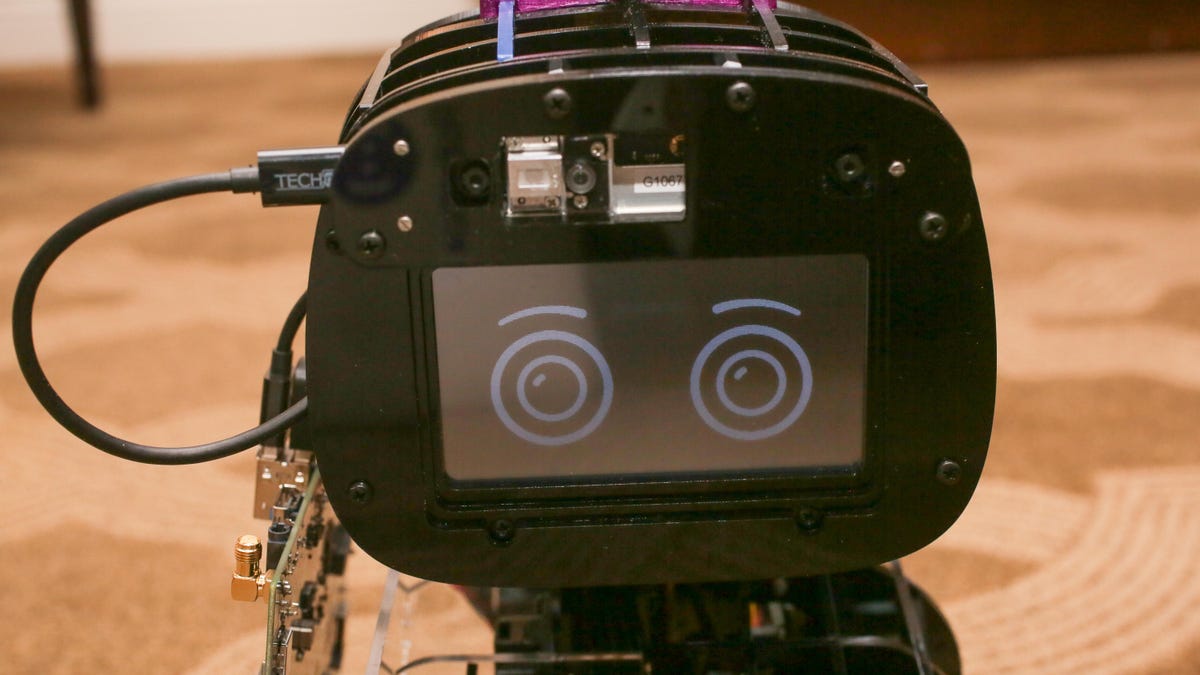Misty Robotics' home robot brings the far-off future to CES 2018
The company has a big vision for the home robotics landscape. Misty I is a baby step -- a dev kit coming in February. Here's a first look.

Misty is an early look at a platform, not really a fully ready robot ... yet.
The little rolling robot in front of me is mostly circuitboards, its camera sensors and parts exposed. It looks a little like Wall-E without the forklift -- or like the many other cute robots flooding CES in Las Vegas.
This one beeped like BB-8, and spun a dance when it saw my face. I knelt down, unsure what to do with it. That's the problem with large-scale robotics: What next?
There are lots of companies throwing robot ideas against a wall. Sphero has made a name for itself with robot toys such as the rolling BB-8 from Star Wars, a practically movie-accurate R2-D2 and a realistic Lightning McQueen from "Cars."
Misty I, as this robot is called, is about the size of a cat. It's not elegant yet, but that's because it's a developer prototype.
Misty Robotics is a spin-off startup company created last year by Sphero founder, Ian Bernstein, and Tim Enwall, who came from Nest Labs. And right now, it looks like the goal of Misty is to encourage people to make robots -- Misty, in particular -- better.
Misty rolls around, and can see thanks to a Occipital camera array that maps visuals.
It's not a robot for now, said Enwall and Bernstein. It's a robot for 10 years from now.
That's Misty Robotics' roadmap: a whole decade. In the tech world, that feels like an infinity. But there are reasons. Over the next three years, according to Bernstein and Enwall, the goal is to build a community of developers and a host of skills for Misty. The Misty I Developer Edition will be available in February for $1,500 (about £1,100 or AU$1,900) to a "dozen" or so early partners.
It'll be followed by a more polished Misty II later in the year. At that laptop-range price, Bernstein thinks programmers will see Misty the way programmers saw the personal computer in the '70s.
It's hard to see much in Misty I's current form. I met recent hire Ben Edwards, who worked on growing SmartThings' developer community, and heads up Misty's community. He also suggested that the ideas for Misty can rise out of shared ideas.
Misty is compatible with Arduino, and the plan is to make add-on accessories and hardware ideas easy to install.
Misty has open hardware -- USB and serial accessories can be snapped in -- and programmers can use JavaScript, or Blockly, a graphic language that's easier for nonprogrammers to figure out. Sphero has its own coding-friendly hub, EDU, that works across its product line. Misty is a bit like a super flexible big sibling.
A peek at what it's like to program Misty using Blockly, a visual programming language.
Enwall and Bernstein admit that the current smart home landscape is full of competing voice assistants, platforms that aren't solidified, and appliances that aren't all self-aware. Maybe in a handful of years, the situation will settle down and allow robots like Misty to thrive. The company seems fine with playing the long game.
I think the most interesting part of Misty is that it's also a bit of a test bed for future Sphero toys. Bernstein agrees with me. Maybe the next wild robot toy after R2-D2 and BB-8 is sitting somewhere in Misty's skeletal structure.
PC preview: What to expect from laptops, desktops and tablets at CES this year.
CES 2018: CNET's complete coverage of tech's biggest show.

